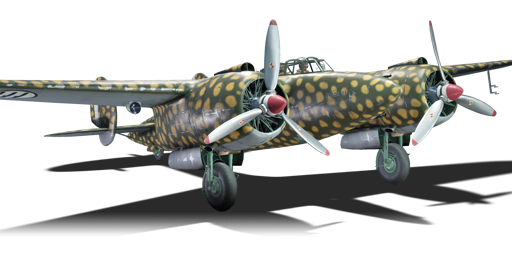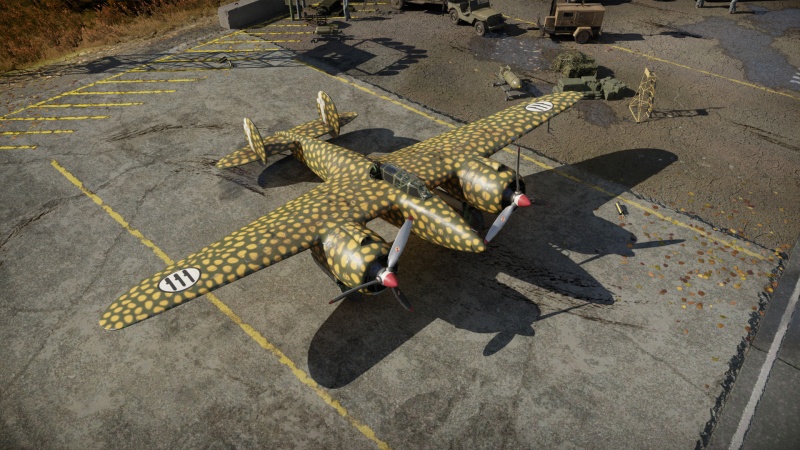Breda 88 (P.XI)
Contents
Description
The Breda 88 (P.XI) "Lince" (Italian for Lynx) is a rank I Italian strike aircraft with a battle rating of 1.7 (AB/RB) and 2.0 (SB). It was introduced in Update 1.69 "Regia Aeronautica".
Being developed in the mid-'30s the design goal was alike to many other bombers of the period: Use the bigger frame to mount even bigger engines to outrun any fighter. Setting up multiple records the Prototype Ba.88 exceeded its expectations. It was amazingly fast for its time, and was used as an air racer, too.
But unfortunately, the prototype is NOT the final aircraft the Italian air force ended up with and NOT the version found in War Thunder. For the crucial mistake came when it was time to mount military instruments, self-sealing fuel tanks, weapon pylons, a second pilot, and armament consisting of guns, bullets and bombs. The additional weight from all this hardware turned the Lince effectively into a brick and a less-effective flying one at that. In fact in comparison, the same ranked SM 79 Sparviero medium bomber is overall a better attacker than the Breda. While the high weight and streamlined fuselage of the aircraft typically lend this type of aircraft to Boom & Zoom, getting to this point is a chore. Fortunately, the Breda 88 is so low tiered that it will indeed often face slower fighter craft. At the very least the Ba.88's three nose-mounted heavy machine guns are decent with plenty of ammo.
General info
Flight performance
With all of the additional necessary gear and equipment added to the first production series after the prototype, the Breda 88 is hopelessly overloaded (137 kg/m² wing-load) and drains any advantage the streamlined design and strong engines grant. In fact on first glance the Lince appears to be quite responsive, featuring late control lock-up speeds and decent roll-rate once spinning. But in this lies the crux of the matter. The aircraft is too heavy, any maneuver pulled must change the momentum of the aircraft, hence any steering and course correction is linked to a loss in speed and/or altitude to compensate. It bleeds speed everywhere thus seriously hampering its ability to Boom & Zoom effectively which one would think the Breda is destined for. Crawling to its ground-level top speed of 410 km/h IAS Boom & Run tactics might work against biplanes...
Take off on empty is @ 150 km/h IAS (136 f/s) in 18 s, attempting an Immelmann at top speed will cause the aircraft to stall at its zenith and a Split-S should only be performed with +500 m (1,650 ft.) to spare or else impact with the ground will be a given. When attempting to gain altitude, climbing should be done at ~10° when loaded and @ 12° when empty. These data points were not copied from an Italian medium bomber, but rather are a show of inferiority compared to any other attacker at its battle rating. On the bright side, the difference between full and empty payload is minuscule.
| Characteristics | Max Speed (km/h at 5,600 m) |
Max altitude (metres) |
Turn time (seconds) |
Rate of climb (metres/second) |
Take-off run (metres) | |||
|---|---|---|---|---|---|---|---|---|
| AB | RB | AB | RB | AB | RB | |||
| Stock | 476 | 462 | 9800 | 29.9 | 30.9 | 6.0 | 5.9 | 730 |
| Upgraded | 504 | 490 | 28.1 | 29.0 | 9.3 | 7.6 | ||
Details
| Features | ||||
|---|---|---|---|---|
| Combat flaps | Take-off flaps | Landing flaps | Air brakes | Arrestor gear |
| X | ✓ | ✓ | X | X |
| Limits | ||||||
|---|---|---|---|---|---|---|
| Wings (km/h) | Gear (km/h) | Flaps (km/h) | Max Static G | |||
| Combat | Take-off | Landing | + | - | ||
| 712.5 | 262 | N/A | 388 | 283 | ~9 | ~5 |
| Optimal velocities (km/h) | |||
|---|---|---|---|
| Ailerons | Rudder | Elevators | Radiator |
| < 360 | < 320 | < 400 | > 200 |
| Compressor (RB/SB) | ||
|---|---|---|
| Setting 1 | ||
| Optimal altitude | 100% Engine power | WEP Engine power |
| 4,000 m | 1,000 hp | N/A |
Survivability and armour
Designed to outrun any interceptors, the designers at Breda opted to forego any kind of armour protection. A shame that the Lince cannot do that. While the central fuselage tank may shield from a few pursuit shots, any frontal attacks are very likely to take out the entire crew in a single burst. This aircraft lacks in manoeuvrability leading to an overall short service life both in real life and game. Though the radial engines are rather resilient, not that it improves the survivability much.
Modifications and economy
Armaments
Offensive armament
The Breda 88 (P.XI) is armed with:
- 3 x 12.7 mm Breda-SAFAT machine guns, nose-mounted (375 rpg top + 425 rpg middle + 450 rpg bottom = 1,250 total)
The three heavy machine guns are arranged and located in the nose of the aircraft. Usually, the slow firing Breda HMGs are a lacklustre affair, but the addition of a third gun elevates the firepower to just mediocre. Each is armed with different amounts of ammunition, which when firing will run empty at different times. Using tracer belts with one of the guns is a very handy visual feedback in Simulator Battles and a neat visual gimmick in other game modes.
Both "Air Targets" and "Stealth" belts are great against aircraft with their IAI-bullets (high explosive rounds), albeit their fuses may not trigger on the canvas skins of biplanes. Against ground targets, the API-T only "Tracer" belt is recommended.
Suspended armament
The Breda 88 (P.XI) can be outfitted with the following ordnance:
- Without load
- 3 x 50 kg GP 50 bombs (150 kg total)
- 3 x 100 kg GP 100 bombs (300 kg total)
In Realistic and Simulator battles the outer bomb pair drops first with a second drop available for the central third bomb. Due to the aircraft's slow change of momentum, any dive bombing attempt below 600 m (2,000 ft) may result in unplanned self-destruction. Unfortunately, no bombsight with this attacker is available, nor does it feature a floor window for target acquisition. The plane's handling hardly changes with the payloads so the triple 100 kg one is always recommended.
Defensive armament
The Breda 88 (P.XI) is defended by:
- 1 x 7.7 mm Breda-SAFAT machine gun, dorsal turret (500 rpg)
Provides rear cover from enemy fighters which will try to knock you out. The 7.7 mm has a limited firing arc. However, controlling the aircraft allows it to be compensated for. It is best to aim for the engine and fight deck of the enemy fighter to knock it out.
Usage in battles
The Breda Ba.88 (P.XI) should be used to attack ground targets, for aerial manoeuvres it simply lacks the grace or flying ability necessary. Yet even ground strafing can be difficult due to sluggishness and even deadly as the pilot is extremely vulnerable. Try to avoid enemy planes if possible, as any enemy that engages on its own accords may prove to be fatal. Also note the Ba.88 can carry bombs but does not have air brakes or bombsights, so one must manually slow down and estimate the payload release on target.
Few viable ways of engaging enemy aircraft exist and all rely on surprising the hostile vehicle. Gaining altitude and diving on the enemy ("Boom") and then either climbing ("Zoom") or running away in level flight are recommended. Albeit this heavy fighter will greatly lose speed in any manoeuvre hence any correction for leading the target should be avoided. Bombers and other aircraft with defensive armament should be avoided entirely.
Manual Engine Control
| MEC elements | ||||||
|---|---|---|---|---|---|---|
| Mixer | Pitch | Radiator | Supercharger | Turbocharger | ||
| Oil | Water | Type | ||||
| Controllable | Controllable Not auto controlled |
Controllable Not auto controlled |
Controllable Not auto controlled |
Separate | Not controllable 1 gear |
Not controllable |
Pros and cons
Pros:
- Tremendous fuel load (33 minutes of fuel is the minimum)
- Reasonable armament with a high chance of igniting fuel tanks
- Payloads have almost no performance penalty
- Payloads are useful for attacking light tanks, Artillery, AAA, and vehicles such as Armored Cars
Cons:
- Flying brick of an attacker
- Poor roll rate, turn time, rate of climb, top speed and anything really
- Will get absolutely murdered in a turn fight
- Lack of any armour for protection
- Plane is prone to pilot snipe
- Poor defensive armament
- Does not have bombsight
- Deadweight in the line-up
History
The Breda Ba.88 was an Italian heavy fighter bomber that was made for the Regia Aeronautica's 1936 requirement for a twin-engine heavy fighter capable of 329 mph, 2000 km range, and capable of carrying 20 mm cannons. It made its debut around late 1936 to 1937 and during its evaluation, it was a promising design. Standard firepower of the plane was three 12.7 mm Breda SAFAT machine guns in the nose and a gunner in the dorsal turret with a 7.7 mm Breda SAFAT machine gun. The prototype aircraft flew with two Isotta-Fraschini K14 series while production models of the plane had two Piaggio P.XI RC.40 "Stella" 14-cylinder air-cooled radial engines capable of 1,000 hp each, setting several new world speed records in 1937, with speeds in the 550 km/h range. By 1938-39 the Breda Ba.88 came into production but it would be retired in 1941 with only 149 made, after only brief service in Libya in the summer of 1940. The plane was found to perform much more poorly with an operational bombload and unsuitable for the designated role of heavy fighter/assault.
Media
- Skins
- Skin: Semi-historical 7° Stormo camouflage - by _IronSun_
- Skin: Fictional Navy camouflage - _IronSun_
- Videos
See also
External links
- [WT Forum] Breda Ba.88 discussion thread
- [WT Forum] Official data sheet - more details about the performance
- [Wikipedia] Breda Ba.88
- [Devblog] Breda Ba.88 Lince: A Wild Spirit
| Italian Society Ernesto Breda (Società Italiana Ernesto Breda) | |
|---|---|
| Attackers | Ba.65 (K.14) L · Breda 88 (P.XI) |
| Italy strike aircraft | |
|---|---|
| Ba.65 (K.14) L · Breda 88 (P.XI) · F.C.20 Bis · P.108A serie 2 | |
| Ro.57 Quadriarma · SM.91 · SM.92 | |
| Hungary | ◐Bf 110 G-4 · ◔IL-10 |
| Romania | Hs 129 B-2 (Romania) |





